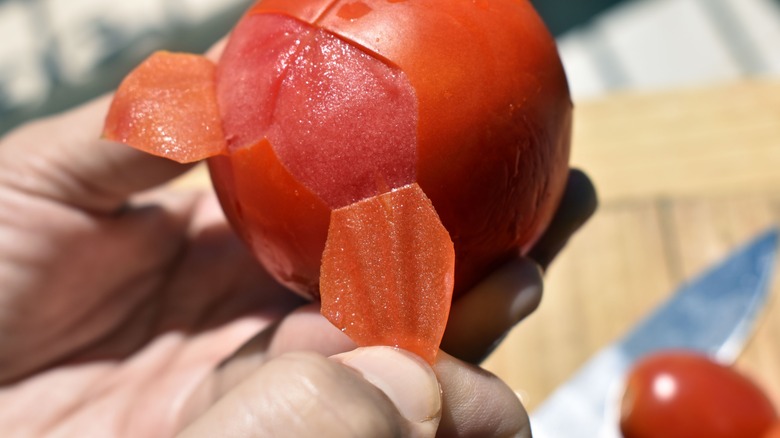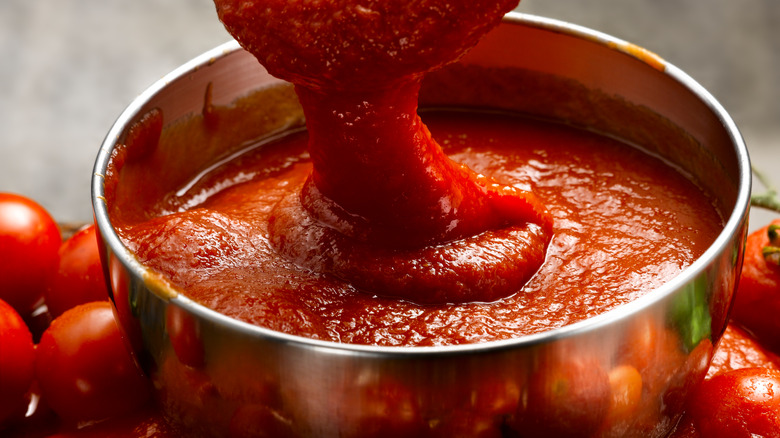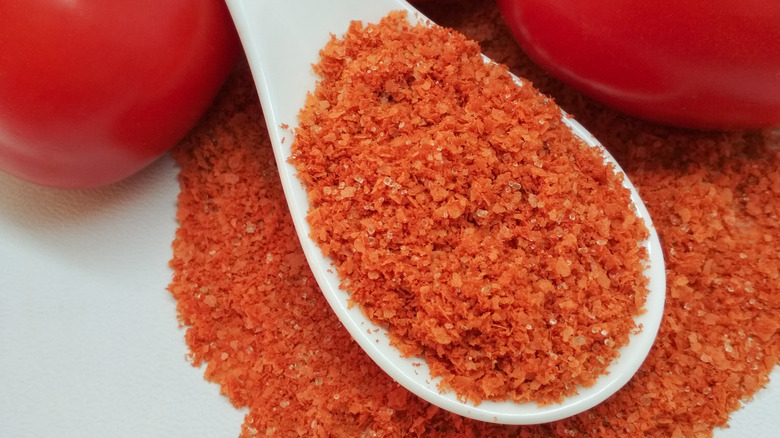Instead Of Peeling Tomatoes, You Should Consider Grating Them Instead
The world wouldn't be the same without one of the most popular vegetables, the tomato. We wouldn't be able to indulge in a chewy Neapolitan pizza without the glorious San Marzano tomatoes, and it's not only Italians that would be left in tears without their staple ingredient — Spaniards wouldn't be slurping their gazpacho during the hot siesta, and the tomato throwing festival in Valencia would have to be canceled.
The tangy juiciness of the prime tomato has the ability to really seduce us, and we're sure to always have some tomato sauce or canned tomatoes in our pantry (probably both). But what if the tomatoes are fresh and we want to crush them for a spicy Roman penne all'arrabbiata? To peel or not to peel the tomatoes is definitely a topic for debate, although the chefs have unanimously agreed that the skins must come off. So let's find out why, and if we follow their advice, we might as well not let the peel go to waste.
Why do chefs swear for tomato peel to be removed
One of the most common tricks chefs use to quickly peel the tomatoes for recipes is blanching tomatoes briefly in boiling water before carefully removing the skin with a knife. Simon Hopkinson, a former chef and food writer, believes that peeling tomatoes is an important step in preventing tomato sauce from becoming bitter, via The Guardian. Unpeeled tomatoes don't look pretty either, and he's probably right — no one wants a sauce full of floating tomato skins.
While peeling tomatoes is elementary for cooked sauces, Selin Kiazim, the chef at Oklava restaurant in London, also swears by using peeled tomatoes in salads, via The Guardian. According to Kiazim, the peeled tomatoes soak up the flavor of the dressing beautifully. Interestingly, she thinks that the old-fashioned way of peeling tomatoes that most classically trained chefs use (blanching the tomatoes and peeling them with a knife) isn't usually worth the hassle. Instead, Kiazim suggests a simple Mediterranean trick to separate the flesh of the tomato from the skin. Just as the Spaniards prepare the tomatoes for their tostadas, Kiazim cuts the fresh tomato in half and rubs it through a coarse grater.
Creative ways to use the leftover tomato skin
Even though peeling tomatoes adds a smooth touch to sauces, there are sustainability advocates among us who would argue against this wasteful practice. The good news is that it doesn't have to be wasteful at all. We certainly don't want something so valuable to go to waste. According to a 2016 study published in the "Arabian Journal of Chemistry", tomato skins contain a decent amount of antioxidants and are used as a dietary supplement.
Next time you're faced with a tomato skin dilemma, save them and freeze them for later. Frozen tomato skins are perfect for making broth — they add a nice depth to the stock as well as zest that cuts through the fat of the meat nicely. If you want to preserve the full nutritional power of the tomato skin, dehydrate it and grind it into a superfood powder. Use a pinch of the powder in a salad or better try it as a meat rub — you'll thank us later.


